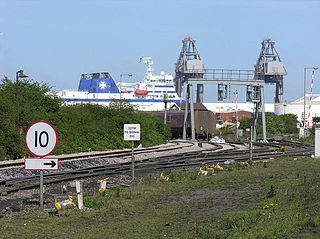
East Halton railway station was located on Skitter Road north of East Halton, Lincolnshire, England.

Killingholme railway station was located on Killingholme Marsh in the parish of South Killingholme, Lincolnshire, England, equidistant from the villages of North and South Killingholme.

Immingham Dock railway station served the dock at Immingham, Lincolnshire, England.

Immingham Dock electric railway station was the western terminus of the inter-urban Grimsby and Immingham Electric Railway which ran from Corporation Bridge, Grimsby with a reversal at what was euphemistically called Immingham Town.
Grimsby electric railway station was the eastern terminus of the Grimsby and Immingham Electric Railway, the western terminus being Immingham Dock, 7 miles (11 km) to the north west.

New Holland Pier railway station is a former railway terminus in North Lincolnshire, England. It stood at the seaward end of the New Holland Pier, which juts 1,375 feet (419 m) northwards into the River Humber at the village of New Holland. Its purpose was to enable railway passengers, vehicles and goods to transfer to and from ferries plying between New Holland and Hull.

Killingholme Admiralty Platform railway station, known locally as Admiralty Platform, was near North Killingholme Haven, Lincolnshire, England.

Grimsby Pier railway station was sited on the now demolished pier with the same name in Grimsby, England.

Immingham Western Jetty railway station was the first railway station which served the dock in Immingham, Lincolnshire, England. It was replaced by Immingham Dock.
New Holland Town railway station is a former railway station in the village of New Holland in North Lincolnshire, England. It stood at the landward end of the pier, whilst the purpose of Pier station, which juts 1,375 feet (419 m) northwards into the River Humber, was to enable railway passengers and goods to transfer to and from ferries plying between New Holland and Hull. New Holland Town station's purpose was for more conventional use by the local community.
Grimsby engine shed was a railway locomotive maintenance depot located southeast of Grimsby Docks station in North East Lincolnshire.
Kiln Lane electric railway station was situated at the eighth of eight passing loops on the otherwise single track central "country" section of the inter-urban Grimsby and Immingham Electric Railway when travelling from Corporation Bridge, Grimsby to Immingham Dock.
Cleveland Street electric railway station was the fifth of five calling points on the 1+1⁄4 miles (2.0 km) eastern, "street" section of the inter-urban Grimsby and Immingham Electric Railway when travelling from Corporation Bridge, Grimsby to Immingham Dock.
Stortford Street electric railway station was the fourth of five calling points on the 1+1⁄4 miles (2.0 km) eastern, "street" section of the inter-urban Grimsby and Immingham Electric Railway when travelling from Corporation Bridge, Grimsby to Immingham Dock.
Boulevard Recreation Ground electric railway station was the third of five calling points on the 1+1⁄4 miles (2.0 km) eastern, "street" section of the inter-urban Grimsby and Immingham Electric Railway when travelling from Corporation Bridge, Grimsby to Immingham Dock.
Jackson Street electric railway station was the second of five calling points on the 1+1⁄4 miles (2.0 km) eastern, "street" section of the inter-urban Grimsby and Immingham Electric Railway when travelling from Corporation Bridge, Grimsby to Immingham Dock.
Yarborough Street electric railway station was the first of five calling points on the 1+1⁄4 miles (2.0 km) eastern, "street" section of the inter-urban Grimsby and Immingham Electric Railway when travelling from Corporation Bridge, Grimsby to Immingham Dock.

Ulceby Aerodrome Platform railway station was situated 74 chains (1.5 km) northeast of Ulceby North Junction between Ulceby and the village of South Killingholme, Lincolnshire, England. It was opened by LNER to serve the Second World War airfield RAF North Killingholme, whose southern perimeter lay a short distance to the north.
Immingham Halt railway station was a temporary terminus serving people involved in building Immingham Dock, Lincolnshire, England. It was originally named "Immingham Road", but was renamed Immingham Halt when it was upgraded from an unadvertised halt for contractors' workmen to a publicly advertised station in 1910, though it appeared in Bradshaw as plain "Immingham".
Grimsby Pyewipe Road railway station was a temporary terminus serving people involved in building Immingham Dock, Lincolnshire, England.









